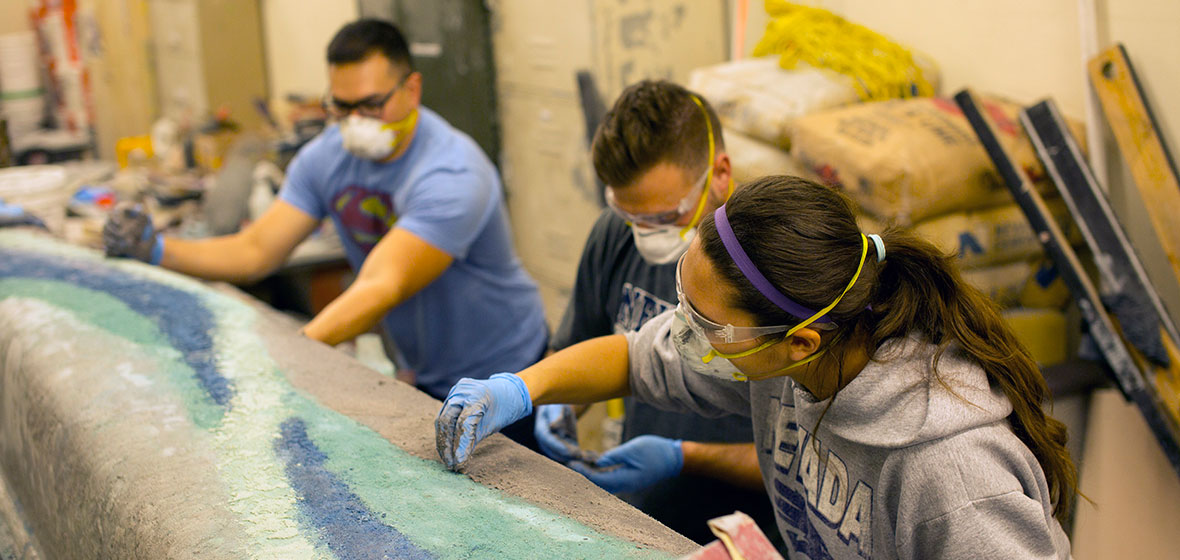The American Society of Civil Engineers Mid-Pacific Conference gives civil engineering students in Nevada and northern California the opportunity to practice their skills in a variety of competitions, including the construction and racing of canoes built out of concrete. Each year, the competition gives students experience in teamwork, budgeting, designing and communicating; all meant to enhance skills essential to future careers.
"We are very proud of the hard work and effort our students put into the Mid-Pac competitions each year," Kelly Doyle, program coordinator for the University's Center for Civil Engineering Earthquake Research, said. "The conference is a lot of fun and the students learn so much throughout the process."
The conference is being hosted this year by the University of Nevada, Reno April 7-9 with the canoe events at the Sparks Marina. The University's concrete canoe team has had a formidable record, earning one of the top five spots since 2007 at the National Concrete Canoe Competition.
Teams are judged in four categories, including a technical design paper, oral presentation, final product - including aesthetics, buoyancy and durability - and the races. The race portion includes five events: men's and women's' endurance, men's and woman's sprint and co-ed sprint. At the national competition, teams win $5,000, $2,500 and $1,500 scholarships for first, second and third place. But the money is not the point for the hard-working students, who also have full class schedules.
University students have the opportunity to join the team in the annual design, construction and racing of canoes made out of concrete. Some participants are not even members of the 15-person team, but still want to share in the enjoyment of the team project.
During childhood Guillermo Munoz was told he would become a great engineer one day, and the idea stuck with him. He became a fan of the program after watching the concrete canoe races at the regional competition in Davis, California two years ago. He enjoyed watching it so much he wanted to be involved. Not only has he become a paddler, but he also specializes in the construction of the cross section as well as disc-jockeying the crew's tunes during construction.
"There are many nights where we easily work until the morning," Munoz said. "During these nights, members are tired, exhausted, irritable and on the verge of cracking. If we can learn to work with each other while at our lowest, we can work with anyone. Last year, we put in roughly 4,000 hours into the canoe. Spending so much time together - designing, building and racing the canoes - my team feels like family."
Otto Tang has always aspired to help improve the world, and sees no better field than civil engineering to make a positive impact. Not an official team member this year, he is helping regularly, just for fun. Many previous members such as Tang are spending their free time helping and sharing their knowledge and experience with newer members. He said this opportunity is helping him improve upon his teamwork and leadership skills with fellow engineers.
"We're schooled and trained to be problem solvers, and so it comes with the territory of having differing views on how to resolve an issue or accomplish a task," Tang said. "This thought diversity provides an opportunity to hone our own logic and problem-solving skills, but also allows us to see possibilities in a different perspective."
Janae Johnston said she realized what she wanted to do with her life after finding herself staying up until dawn researching balanced bridge distribution without noticing the time. With career dreams ranging from an Imagineer with Disney to working with United Search and Rescue, all she knows for sure is that she would love to work in a position that combines artistic features with structural elements. An artist, Johnston is this year's graphic manager for the team.
Instead of using stains to decorate the canoe as in past years, the requirement this year, for all 200 teams who compete nationwide, is to use pigment in the concrete mix, limiting patterns to what could be created with the concrete placing itself, a daunting challenge for Johnston's first year in the program.
"In the design field, challenges like this come up all the time, so your success really boils down to knowledge you can gather from other people as well as the information you have to find and figure out for yourself," Johnston said. "Because we are a highly competitive team, we are fortunate enough to bear the name with pride and be recognized for our efforts and hard work."
The crew believes that with the hard work and dedication they have put into the project they could be a shoe-in for nationals. To get there, they will need to win first place at the regional competition, held this year at the Sparks Marina. In preparation, the paddlers have been meeting most every Saturday morning since September to practice paddling together.
They worked throughout the fall on design and analysis. At the beginning of the year, they cast the canoe and let it dry for a month. From then until the conference in April, they will be sanding, staining and sealing the exterior.
Along with the University of Nevada, Reno, 15 universities are in the Mid-Pacific region, including the University of California, Davis; Tongji University from China; Cal State University, Fresno and arch rivals University of California, Berkeley.











